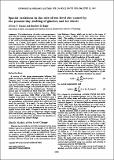Spatial variations in the rate of sea level rise caused by the present-day melting of glaciers and ice sheets
Author(s)
Conrad, Clinton P.; Hager, Bradford H
DownloadHager_Spatial variations.pdf (666.1Kb)
PUBLISHER_POLICY
Publisher Policy
Article is made available in accordance with the publisher's policy and may be subject to US copyright law. Please refer to the publisher's site for terms of use.
Terms of use
Metadata
Show full item recordAbstract
The redistribution of surface water mass associated with the melting of glacial ice causes uplift near areas of mass depletion, depression of the seafloors, and changes in the earth's gravitational field which perturb the ocean surface. As a result, local spatial variations exist in the rate of sea level rise. Tide gauges on continental coastlines measure a sea level rise 5% smaller than the global average. Tide gauges in the hemisphere opposite a source of continental mass depletion measure sea level rise 10 to 20% greater than the global average produced by that source while satellites make measurements 10% too low. Because most long duration tide gauges are in the northern hemisphere, if the sources of sea level rise are unbalanced between the two hemispheres, estimates of global sea level rise could be in error by 10 to 20%. Individual tide gauges could be more seriously unrepresentative if they are near regions of significant present-day mass depletion.
Date issued
1997-06Department
Massachusetts Institute of Technology. Department of Earth, Atmospheric, and Planetary SciencesJournal
Geophysical Research Letters
Publisher
American Geophysical Union (AGU)
Citation
Conrad, Clinton P., and Bradford H. Hager. “Spatial Variations in the Rate of Sea Level Rise Caused by the Present-Day Melting of Glaciers and Ice Sheets.” Geophysical Research Letters 24.12 (1997): 1503–1506. © 1997 American Geophysical Union
Version: Final published version
ISSN
00948276